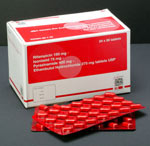

Talen:


Tuberculosis (TB) is a pulmonary bacterial infectious disease that spreads through the air. When people who are sick with TB in their lungs cough, sneeze, talk or spit, they propel TB germs into the air, and a person needs only to breathe in a small number of these to be infected.
Overall, one-third of the world's population is currently infected with the TB bacillus, the bacterium that causes tuberculosis. However, most of these people infected with TB will never become sick or infectious as their immune system keeps the infection in check.
People with a weakened immune system have a greater chance of becoming sick with tuberculosis, particularly if they are also infected with HIV. TB is one of the major causes of death in people who are HIV-positive, and HIV is the most important factor responsible for the rise of TB in Africa since 1990.
The proportion of people in the general population who become sick with tuberculosis each year is stable or falling worldwide but, because of population growth, the absolute number of new cases is still increasing. In 2005, South-East Asia had the largest number of new cases but the highest proportion of new cases and TB-related deaths was found among the African population. About 1.6 million people worldwide died from tuberculosis that year.
Although antibiotics to cure TB have only been available for the past 50 years, forms of tuberculosis that are resistant to the major anti-TB drugs have emerged worldwide. Drug-resistant tuberculosis is caused by inconsistent or incomplete treatment, when doctors prescribe the wrong treatment or when patients do not take all their medicines regularly for the required period.
Multidrug-resistant tuberculosis (MDR-TB) is a dangerous form of tuberculosis that is resistant to at least isoniazid and rifampicin, the two most powerful “first-line” anti-TB drugs. Usually, multidrug-resistant tuberculosis can be cured with long treatments of “second-line” drugs, but these are more expensive than first-line drugs and have more adverse effects.
When the rate of multidrug resistance in an area is high, it becomes increasingly difficult to control tuberculosis. This threat is even more serious because of the emergence of extensively drug-resistant tuberculosis (XDR-TB), particularly in settings where there are many patients who are also infected with HIV. XDR-TB is caused by strains of the disease resistant to both first- and second-line antibiotics. This confirms the urgent need to strengthen TB control.
In 2006, The WHO launched the Stop TB Strategy, a new approach that aims at halting the progression of tuberculosis by 2015, and to eliminate it as a public health problem by 2050. The six components of the Stop TB Strategy are:
This text is a summary of: WHO,
Fact sheet N°104, Revised March 2007![]()

This summary is free and ad-free, as is all of our content. You can help us remain free and independant as well as to develop new ways to communicate science by becoming a Patron!